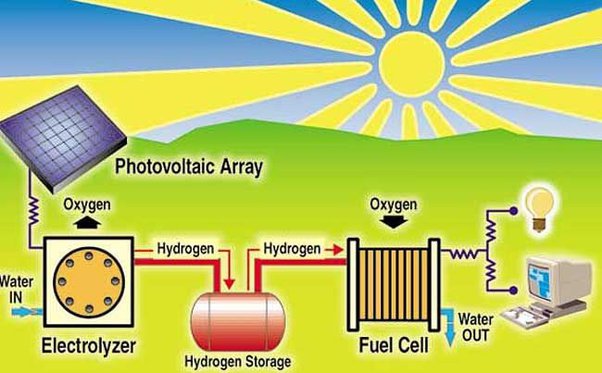Hydrogen Solar Panel For Sustainable Energy 24
Hydrogen Solar Panel
Sustainable energy generation and storage can be achieved through the unique use of hydrogen solar panels. Using photovoltaic cells, these solar panels, like conventional solar panels, harness the power of sunshine to generate electricity.
Water electrolysis is the procedure that gives hydrogen solar panels their special capacity to simultaneously create and store hydrogen gas.
Hydrogen solar panels can be thought of as photovoltaic cells that incorporate an electrolyzer to split water molecules into hydrogen and oxygen gases. Following production, the hydrogen gas can be stored and used at a later time as a flexible and clean energy source.

The ability of hydrogen solar panels to mitigate the sporadic nature of solar power output is one of their main benefits. During times of maximum sunlight, these panels store excess solar energy as hydrogen gas, which can be used when there is a shortage of sunlight or increased demand.
Additionally, hydrogen is regarded as a clean energy source since it doesn’t produce any pollutants or greenhouse gases when it’s used in fuel cells or combustion processes. For this reason, hydrogen solar panels represent a potentially useful technology in the fight against carbon emissions and the shift to more environmentally friendly energy sources.
Basic Principles of Hydrogen Solar Panel
The process of photocatalytic water splitting—a type of artificial photosynthesis—is sparked by these panels using sunlight and water vapor. Taking advantage of this process, solar hydrogen panels can minimize the conversion losses frequently found in conventional solar-hydrogen energy cycles by producing hydrogen gas directly, eliminating the need for intermediate processes.
By adopting this novel strategy, we can reduce our dependency on fossil fuels and advance renewable energy solutions.
Describe how a hydrogen panel is made.
In order to convert solar energy into electricity, the PV panel is the main component involved. The electrolyzer uses the electricity produced by the PV panel to help transform water into hydrogen and oxygen. Direct hydrogen gas production is made possible by this procedure, and hydrogen gas can be gathered and used for a variety of purposes.
The hydrogen that has been gathered can be tube-stored and delivered to houses or businesses so that it can be used in fuel cells to provide electricity for lighting up buildings. These solar panels also produce hydrogen, which can be used as a clean fuel source for hydrogen-powered cars. This helps with efforts to reduce greenhouse gas emissions by providing an alternative to conventional fossil fuels.
Follow our Digiknowledge.co.in page for the latest updates about technology, bikes, cars, sports, lifestyle, and many more.
What is the efficiency of a hydrogen solar panel?
An inventive technique for transforming solar energy into hydrogen gas, which can subsequently be utilized as a clean and adaptable energy supply, is solar-to-hydrogen fuel cells. Though normal system efficiencies range from 5% to 20%, technological improvements have allowed some systems to achieve efficiencies higher than 20%. As evidence of the possibility for more advancements in this area, the highest documented solar-to-hydrogen conversion efficiency reached 30%.
It is noteworthy that the efficiency of hydrogen fuel cells, which directly transform hydrogen into electricity, is generally higher than that of solar-to-hydrogen systems; the range of efficiencies is from 40% to 60%.
Still, there is hope for improving the overall efficiency and feasibility of producing hydrogen energy with the development of more effective solar-to-hydrogen systems.
To fully utilize solar-to-hydrogen technology and get closer to a sustainable energy future, more research and innovation in this field are needed.
To improve solar-to-hydrogen fuel cells’ scalability and efficiency for useful hydrogen production, research is constantly being done in this area. A major development in this sector is the solar panel produced at the University of Michigan, which you gave as an example.
This solar panel has the potential for huge efficiency advancements, as evidenced by its impressive 9% efficiency compared to earlier solar water-splitting tests.
For researchers looking to improve the efficiency of solar-to-hydrogen systems, advances in electrolyzer technology as well as advances in solar panel design, materials, and manufacturing processes are important areas of study.
Through enhancing performance and expandability, these endeavors seek to render solar-to-hydrogen fuel cells more financially feasible and attainable for extensive integration, ultimately aiding in the shift towards a more sustainable future of renewable energy.
How can the cost of green hydrogen be reduced?
In the past ten years, the price of electrolyzers has dropped by 60%, and by 2030, it is predicted to drop by another 50%. With the decline in the cost of renewable energy, green hydrogen prices may also go down.
What is renewable hydrogen?
Electrolysis is a method of producing hydrogen by splitting water into hydrogen and oxygen with the application of electricity. Greenhouse gas emissions are avoided, and renewable energy is also produced while using renewable electricity for electrolysis.
How do hydrogen-powered solar panels work?
Gas tubes are used in hydrogen solar panels instead of an electric cable, making them comparable to conventional solar panels. In order to create hydrogen, a series of tubes beneath the top layer of the panel employ a membrane to draw water molecules out of the surrounding air.
What are the benefits of solar hydrogen?
Among the main benefits of solar hydrogen are several:
Environmental impact: By offering a clean and sustainable substitute for fossil fuels, it helps to lower greenhouse gas emissions and lessen their negative effects on the environment.
Financial: By assisting in mitigating peak electricity demand charges, solar hydrogen energy storage may result in cost savings for both utilities and customers.
Realistic: Solar hydrogen is a flexible and realistic energy source that may be used for producing heat and power, among other things.
Energy Security: By lowering reliance on imported fuels and diversifying energy sources, investments in hydrogen infrastructure can improve the country’s energy security.
How much hydrogen is needed to generate 1 kW of electricity?
The hydrogen’s LHV is roughly 120 MJ/kg (megajoules per kilogram), and the fuel cell produces one unit of electrical energy.
The required amount of hydrogen can then be computed as follows:
Grams of hydrogen = (1 / 0.83) * (1 / LHV of hydrogen)
We can calculate the necessary amount of hydrogen using the given LHV value:
The hydrogen amount (in grams) is equal to (1 / 0.83) * (1 / 120 MJ/kg) = 0.01074 kg ≈ 10.74 grams.
Therefore, 10.74 grams of hydrogen are required to create 1 unit of electrical energy in a PEM fuel cell with an efficiency of 83%.




